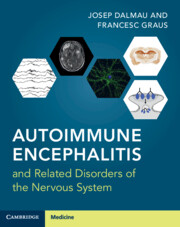Book contents
- Autoimmune Encephalitis and Related Disorders of the Nervous System
- Autoimmune Encephalitis and Related Disorders of the Nervous System
- Copyright page
- Dedication
- Contents
- Clinical Vignettes
- Videos
- Preface
- Abbreviations
- Section 1 Overview
- Section 2 Antibodies and Antigens
- Section 3 Specific Syndromes and Diseases
- Section 4 Autoimmunity in Neurological and Psychiatric Diseases
- Chapter 19 Autoimmune Psychosis
- Chapter 20 Psychiatric Manifestations of Autoimmune Encephalitis
- Chapter 21 Abnormal Movements in Neurological Autoimmune Disorders
- Chapter 22 Sleep and Autoimmunity
- Chapter 23 Immunity, Inflammation, and Epilepsy
- Chapter 24 Autoimmune Dementia: A Useful Term?
- Chapter 25 Frequently Asked Questions on Autoimmune Encephalitis and Related Disorders
- Index
- References
Chapter 20 - Psychiatric Manifestations of Autoimmune Encephalitis
from Section 4 - Autoimmunity in Neurological and Psychiatric Diseases
Published online by Cambridge University Press: 27 January 2022
- Autoimmune Encephalitis and Related Disorders of the Nervous System
- Autoimmune Encephalitis and Related Disorders of the Nervous System
- Copyright page
- Dedication
- Contents
- Clinical Vignettes
- Videos
- Preface
- Abbreviations
- Section 1 Overview
- Section 2 Antibodies and Antigens
- Section 3 Specific Syndromes and Diseases
- Section 4 Autoimmunity in Neurological and Psychiatric Diseases
- Chapter 19 Autoimmune Psychosis
- Chapter 20 Psychiatric Manifestations of Autoimmune Encephalitis
- Chapter 21 Abnormal Movements in Neurological Autoimmune Disorders
- Chapter 22 Sleep and Autoimmunity
- Chapter 23 Immunity, Inflammation, and Epilepsy
- Chapter 24 Autoimmune Dementia: A Useful Term?
- Chapter 25 Frequently Asked Questions on Autoimmune Encephalitis and Related Disorders
- Index
- References
Summary
This chapter focuses on how to recognize anti-NMDAR receptor encephalitis at early stages, when most patients have pure or predominant psychiatric symptoms. We also discuss the differential diagnosis with schizophrenia, acute-onset psychosis, and neuroleptic malignant syndrome, and formulate a general diagnostic and treatment approach to psychiatric symptoms. Anti-NMDAR encephalitis manifests with a wide range of psychiatric symptoms, indistinguishable from that of schizophrenia and other psychiatric diseases, and with a spectrum of psychiatric manifestations that varies according to the stage of the disease. However, >95% of patients develop at early stages of the disease (days or weeks after onset of psychiatric symptoms or concomitant with them) neurological symptoms such as seizures, decreased verbal output, abnormal movements, or dysautonomia. This combination of symptoms usually suggest the diagnosis and prompts NMDAR antibody testing, which should be performed in CSF. The symptomatic treatment of the psychiatric manifestations is largely based on expert opinions, suggesting that conventional antipsychotic drugs should be avoided due to the susceptibility of these patients to developing neuroleptic malignant syndrome. It is unclear whether atypical antipsychotics are associated with lower frequency of these adverse effects, but they are more frequently used. A study suggested that all types of antipsychotic drugs carry a similar enhanced risk of adverse effects, although other studies, and our own experience, suggest that atypical antipsychotics are associated with less adverse effects.
Keywords
- Type
- Chapter
- Information
- Publisher: Cambridge University PressPrint publication year: 2022
References
- 1
- Cited by

